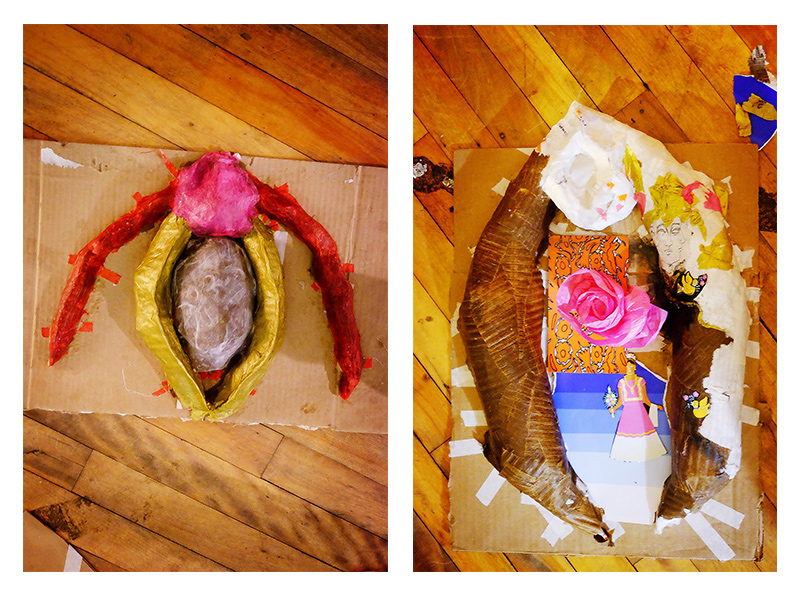Because in a phallus-dominated world, we all need more vulvar imagery
If a friend turned to you on this bus, or wherever you’re sitting right now, and started talking to you about vaginas, how would you react?
This was precisely the topic of discussion that drove the workshops held on Monday and Wednesday evening last week. In a world inundated with phallic imagery, why isn’t there more talk about vaginas and, more importantly, the topics surrounding them?

Hosted by the Centre for Gender Advocacy, this was a workshop not just of discussion but also of craft—vagina puppet-making to be exact. The event took place in the homey loft of Courtney Kirkby, a member of the Centre for Gender Advocacy who is also a journalist, puppet-maker and mental health educator at a community centre. The 10 of us sat in picnic formation with buckets of cardboard that had been soaked in water overnight and hot pots of freshly made corn starch glue between us. Papier-mâché was our medium.
We fashioned labia minora and clitorises from newspaper and empty cans, sticking them onto a cardboard canvas, which we then papier-mâchéed over. As we layered on strips of paper—which was a pretty meditative and cathartic activity in itself—we discussed topics that are generally taboo or rarely mentioned.
Kirkby kicked the evening off by telling us about her background in feminism and puppet-making. It was during a trip to Bolivia that she learnt about Mujeres Creando (which translates to “women growing”), an anarchist feminist collective that relies on the union of sex workers, lesbians and indigenous women.
Established in Bolivia’s capital of La Paz roughly 20 years ago, Mujeres Creando voice their views through art, graffiti, film and street theatre. One of their most controversial performances is a naked protest in which women strip in front of churches and government buildings.
Kirkby had seen a Mujeres Creando docu-fiction, which featured a march where women stopped in the streets of La Paz to publicly tell stories of their experiences with abortion. An illegal practice in Bolivia, abortion has a high death rate due to unsanitary clinics and unsafe protocols. This film was a source of inspiration for Kirkby and her passion for puppet-making, as she enthusiastically described the puppet that these women carried in their march: a giant metal frame of legs joined by a vagina adorned in sheer pink fabric. The women stood under its dome as they told their stories.

We then spoke about la esposa-puta. This concept refers to the sharp divide between prostitutes and “ladies,” which leads women to be seen as dichotomous: they fall into one archetype or the other.
The subjects of transgender and intersex people also arose as we considered how, in contemporary society, the vagina doesn’t necessarily represent a woman in the traditional sense. We also spoke about the lack of accessibility to feminine hygiene products in both developing and developed countries.
There was something very poignant about our engagement in such a charged, political discussion whilst creating very raw, almost childlike pieces of art. The vagina that I made was a joint effort with my friend who also attended. In the end, our puppet-come-artwork looked pretty diabolically tragic. In an attempt to redeem it, we adopted interior design techniques at the decoration stage, wallpapering the labia minora with hearts and embellishing the clitoris with diamantes.
Everyone got truly creative with their pieces. One woman fashioned a rose from pink tissue paper to use as the clitoris. Another of the young women, who works at a veterinary clinic, had asked her colleagues that day whether she could take home the animal hair shavings “to use as pubic hair.” She purposely didn’t mention the vagina puppet-making workshop because she wanted to observe their reactions. Apparently they weren’t surprised and just shrugged it off.
There are two extremes in society: people who recoil at the mention of a tampon, and those who have a coffee-table book of vagina photography, a shelf of vagina-themed felt patchwork and a mantelpiece adorned with a “teddybear” that resembles a vagina (I have a friend who continually receives vagina objects as a joke). This workshop was valuable in bringing such blatantly ignored topics to the fore, and it has left me—and the other nine women, I’m sure—with a lot to ponder. Hopefully, you too.



